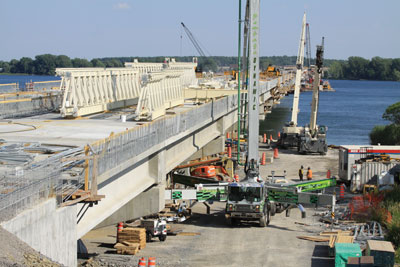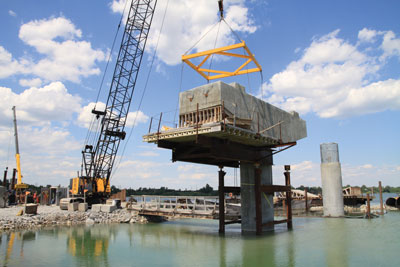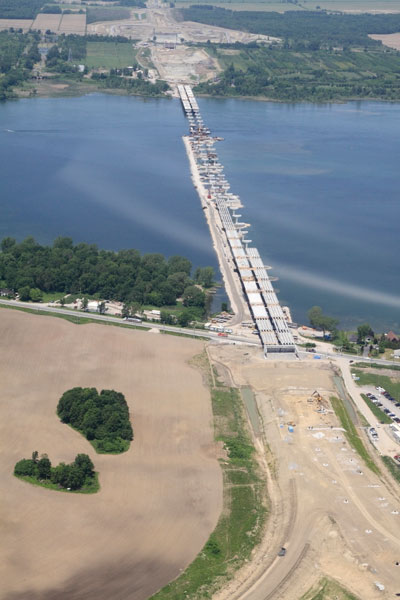
Features
Projects
Roads & Paving
Spanning Half a Century
Fifty years after it was originally started, the long-awaited completion of Quebec’s Highway 30
February 14, 2012 By Martin Forgues
Almost five decades after it began, it seems the long-delayed Highway 30
project will finally be completed by the end of this year.
Almost five decades after it began, it seems the long-delayed Highway 30 project will finally be completed by the end of this year. The work to connect the last two portions of the highway to the rest of the already completed road is currently underway on Montreal’s south shore, most of it as part of a private-public partnership (PPP) involving hundreds of contractors.
 |
|
| Construction of the Saint Lawrence River Bridge, as seen from the North shore. Photo courtesy of Sarah Houde, Nouvelle Autoroute 30, inc.
|
Out of the six construction sites that are simultaneously open, five are operated by a consortium going by the name of Nouvelle Autoroute 30. The company is, until the job is completed, responsible for the construction of the $1.5-billion project’s western portion. Once the highway is open, Nouvelle Autoroute 30 will manage and supervise the maintenance on the same portion of the road.
The History
When originally imagined in the early 1960s, Highway 30 was to answer the need for a high-speed, high-capacity road south of the St. Lawrence River, between the town of Sorel-Tracy and La Belle Province’s main city’s south shore, then connecting it to the westernmost part of Highway 20, which becomes the 401 once across the Ontario border. This road was to allow cars and trucks coming from either Quebec’s south shore or Ontario and the United States to avoid driving through Montreal, especially since the project was initiated a full decade before the first section of another major roadway, Ville Marie Expressway, opened in 1972.
The overall work was never built in a sequential fashion, and construction sites have been scattered over the future road’s design. The then-new Highway 30 (originally christened “Route 3”), was opened to traffic in 1968 as a 6.9-kilometre stretch between Route 116 and Highway 20 in the town of St-Bruno-de-Montarville, 20 kilometres southeast of Montreal.
In the meantime, another site was underway near Salaberry-de-Valleyfield and the 1970s saw the construction of a 9.2-kilometre section linking Valleyfield and St-Thimothée. Tracy and Brossard, which are 80 kilometres apart, were finally connected in 1982. The latter town was connected to Candiac in 1996 and the current works on the eastern part of the highway have been ongoing since 2005, and are expected to be completed late this year. The construction of the private sector-managed western portion started in the spring of 2009 and its opening is scheduled for late 2012.
Such a huge project, of course, comes with problems, delays and controversies. The first significant delay came in 1977 when Quebec’s Department of Transportation decreed an eight-year moratorium on all new roadbuilding projects in the province, bringing to a halt the opening of new sections while allowing existing sites to continue operating.
Another major complication came in 2005 when the Mohawk Tribal Council in Kahnawake demanded to be consulted about any work to be undergone near territories on which they had laid claims, and they opposed the construction of an interchange linking Highway 30 to Highway 730, the latter of which borders the reserve. According to an article published by Montreal’s La Presse in 2008, work was halted in the early summer of 2007 when warrior radicals blocked access to the site. The dispute was never officially settled even though construction has since resumed.
Some controversy was also sparked in 2010 when an engineer working on the western section went public about his concerns over the private consortium’s plan to deal with what he described as major flaws in the design of a bridge that is to cross the St. Lawrence River.
Schedules and Budgets
Now that the project is in its final stage, all that remains is to connect the eastern portion in Candiac to the Highway 20/Highway 540 interchange, located near Vaudreuil-Dorion, making it a 54-kilometre stretch. The western portion for which Nouvelle Autoroute 30 is responsible comprises five sites: the Highway 20/Highway 540 interchange connection; a short, 90-metre-long tunnel under the Soulanges Canal; a two-kilometre stretch that includes a bridge crossing the St. Lawrence; a 2.5-kilometre section including another bridge crossing the Saint-Lawrence Seaway over the Beauharnois Canal; and an interchange linking the highway to Route 138 in Châteauguay.
 |
|
| The trimmer beam during the construction of the Saint Lawrence River Bridge, seen from the South shore. Photo courtesy of Sarah Houde, Nouvelle Autoroute 30, inc.
|
The eastern portion, for which Transports Québec (the provincial department of transportation) is responsible, is much smaller. A nine-kilometre stretch between Candiac and Saint-Constant that links to Highway 730 is already open to traffic. What is to be completed is the overpass, which will be built above boulevard Jean-Leman.
“The aim of this portion of Highway 30 is to provide commuters and truckers with a bypass road and alleviate Montreal’s already problematic road network,” said Transports Québec spokesperson Cynthia Martin.
The recent problems encountered on Montreal’s crumbling road infrastructures will not affect the works on Highway 30. “Completing the highway is somewhat considered a priority for Transports Québec, especially given Montreal’s current issues with traffic,” Martin added. “Schedules will be met.”
This optimism is shared by Denis Léonard, chief executive officer of the private partnership agreement at Nouvelle Autoroute 30. “Going past the current deadline would be too costly not to put our priorities at the right place, and we will respect what we agreed upon with Transports Québec,” he said.
The impact on traffic is thought to be tremendous. According to Transports Québec, the new section, when completed, will relieve Montreal’s road network of an estimated 40,000 vehicles per hour. The department also predicts a significant decrease of 18% in the number of car accidents on existing roads 132 and 201. It will also make access to highways much easier for residents of the western part of Montérégie, reducing the average distance between communities and highways from 18 kilometres to eight kilometres.
Some positive effects might be felt on the economy and the environment as well. Transports Québec estimated that 18,900 jobs – direct and indirect – have been created by the overall project. According to a document released by the department, another 450 jobs will see the light of day annually in newly accessible industrial parks located in western Montérégie. Two hundred million dollars is expected to be saved with the new decreases in transit time through Montreal’s metropolitan area, as well as $25 million in costs directed to the everyday use of motor vehicles, such as gas. When it comes to the environmental impact of having fewer vehicles driving through Montreal, greenhouse gas emissions are expected to decrease by 1% in the metropolitan area.
There has also been a moderate yet inevitable impact on the region’s agriculture. Approximately six square kilometres of arable land has been expropriated to establish the highway’s footprint, 99% of which had already been completed by 2009. According to various sources, little resistance has been met by citizens, farmers and landowners, with the notable exception of the Mohawk traditionalists and environmental activists. “This project will destroy 550 hectares of already disappearing arable land among the most fertile in Quebec, going against the government’s alleged pledge to sustainable development,” a statement by ecological advocacy group Équiterre said.
Where’s the Bus?
While car users and truckers will likely benefit from positive odds of seeing their lives on the road getting easier upon the highway’s final opening, things will not be the same for public transit commuters who want to move among the communities located along Highway 30, such as Vaudreuil, Châteauguay, Saint-Constant and Candiac, each sheltering on average 20,000 to 25,000 residents. While billions of dollars in public infrastructure (commuter trains, reserved lanes for buses, and a future Montreal tramway project) have been announced, Highway 30’s completion doesn’t address the much-documented need for a better public transportation system.
The lack of such an initiative is at first very surprising, given the provincial Liberal government’s official stance of making sustainable development, including improving current public transit networks, a priority. While commuter train and bus lines are accessible to the aforementioned communities, residents who commute to Montreal have very few options to move among those towns. “At Transports Québec, we didn’t address the issue because we think that there is no sufficient demand for public transportation along Highway 30,” said Martin. She also pointed out that since the project completely avoids Montreal, there is little need to improve upon existing networks.
Environmental groups have criticized the absence of public transit agencies at the Highway 30 completion project partnership table over the years. “This government does the opposite of what it says, and while talking about public transit, it strives to put more cars on the road,” said ecological advocacy group Équiterre in a statement.
PPP for the Future
In September 2008, a PPP was signed between Transports Québec and Nouvelle Autoroute 30, inc., a consortium formed by world-leading companies Acciona and Iridium that is charged by Transports Québec with overseeing the western portion of the overall project. The first is also involved in other major projects across Canada – mostly wind farms – and the latter, described by Nouvelle Autoroute 30 as the global leader in establishing public-private partnerships, already has a proven track record, having been responsible for the building of 5,000 kilometres of road as PPPs worldwide. A division of Nouvelle Autoroute 30, inc., Nouvelle Autoroute 30 CJV, inc., composed of companies Dragados Canada, Acciona Infrastructures Canada, Aecon and Verreault, is responsible for design and construction. Two more companies, Arup and S.I.C.E., are on board as “strategic partners”, including consulting. And it doesn’t end there. “On top of that, over 400 contractors are involved in the PPP, creating over 500 jobs in the process,” said Nouvelle Autoroute 30 CEO Léonard.
 |
|
| An aerial photo of the Beauharnois Canal Bridge construction site. Photo courtesy of Sarah Houde, Nouvelle Autoroute 30, inc.
|
And while the PPP inherited the bulkiest part of the project – 42 kilometres out of 54 kilometres – Transports Québec denies having resorted to a PPP to address the popular perception that the public sector is unable to manage major roadbuilding works. “The decision to create a PPP simply reflects current trends in building public infrastructures,” Martin said. This is echoed on Léonard’s side. “A public-private partnership is a very efficient way of meeting schedule and budgetary demands, as there are major incentives for a private conglomerate to complete work within deadlines.”
This PPP is the second of its kind in La Belle Province. Although first announced in 2003 as the upcoming norm for staging and managing future government projects, the concept has been challenged over the years by Quebec’s population and opposition parties as a sneaky way of giving away government infrastructures to the private sector. Such a project – the Suroit natural gas energy plant – was aborted in 2004 due to public pressure. Since then, Transports Québec has signed a PPP to build Quebec’s first privately managed toll bridge on Highway 25 to link the cities of Montreal and Laval.
When work on its part of the highway is completed and before it turns it over to Transports Québec in 2047, the consortium will be responsible not only for maintaining and managing the infrastructure, but also for collecting tolls. According to Léonard, the price should be around 20 cents per axle. But unlike the Highway 25 bridge, which only has an automatic payment system using sophisticated motion sensors and high-speed cameras that capture licence plates, tolling on the western part of Highway 30 will be more conventional. “Our system will still be comprised of the traditional gate system,” added Léonard. “There will also be a subscription-based option for frequent users, using transponders much like the ones installed on the Highway 25 bridge.”
It looks like public-private partnerships might become the norm in Quebec when it comes to roadbuilding. “If this project proves as successful and cost effective as the Highway 25 bridge, there will be more,” noted Martin.
Heavy Work Means Heavy Machinery
Of course, such a major work sees the use of very heavy machinery. Cranes and bridge-laying equipment are put to the task along all six sites. Very busy at this stage are slipform pavers and concrete texturing and curing machines. Demix Construction, a division of Holcim Canada, which specializes in paving, is charged with surfacing the eastern government-managed part of the project.
At work on the Jean-Leman overpass site is the S1500 slipform paver, built by Guntert and Zimmerman, which has been preferred over its little brother, the S850, because the former had the appropriate width capacity required for the overpass, although both have telescopic paving frames.
Also used by Demix is the Gomaco TC-600 concrete texturing and curing machine.
While surrounded by crumbling roads – mainly the result of Quebec’s extreme-changing weather, Highway 30 will not benefit from new construction techniques. “We looked at a very conventional way of building the highway, which is much like the rest,” Léonard concluded.
Much-Needed Relief
The completion of Highway 30 will come to its long-awaited conclusion by the end of next year after years of delays, redesign, political debates and opposition from a plethora of interest groups. The decision made by the provincial government to switch over to a public-private partnership from a more conventional management model can be seen as an initiative to affirm the desire to finally put an end to 50 years of procrastination, be it intentional or not. It’s also paving the way for more PPP-managed projects, confirming the will of Quebec’s authorities – be they provincial or municipal – of going back to tolling to assure proper funding for public infrastructures. In upcoming projects, such as a future new Champlain bridge and the demolition and reconstruction of the much-overdue Turcot interchange, decision-makers are likely to submit PPP proposals.
As Montreal’s road infrastructures keep descending in a steady, fast-paced decline, the need for an alternative is nowadays even more evident than five decades ago, when the project of building Highway 30 was first launched. It’s clear that Quebec’s economic core can’t sustain its current traffic volume, given the hundreds of thousands of vehicles its roads carry every day. It could be argued that such decay might have been at least partially avoided should there have been a viable option for a high-speed road for the portion of the traffic that doesn’t need to drive through Montreal. While it might, as environmentalists fear, put more vehicles on the road, there is no doubt that the completion of Highway 30 will alleviate traffic jams in Montreal’s metropolitan area.
Martin Forgues is a freelancer journalist based in Montreal, Que. He researched and produced this article for Aggregates & Roadbuilding.
Print this page